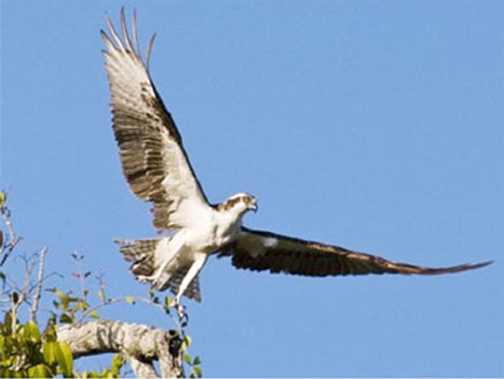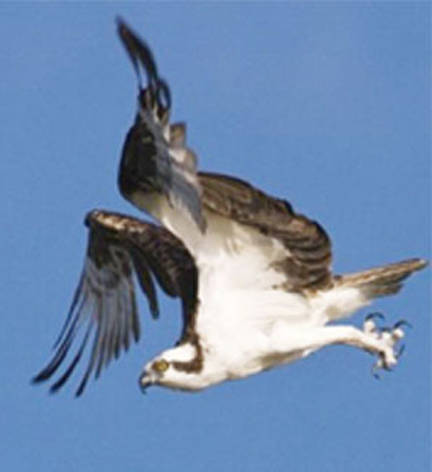Pandion Haliaetus, more commonly known as the Osprey or Fish Hawk, or locally known as ‘Tanuwaka,’ can be found in forested areas near bodies of water. There is only one species of this fish-eating bird of prey, and although it can be found worldwide, it does not breed in South America, preferring to migrate here during the northern hemisphere winter. In Guyana, migrants and young Ospreys can be commonly seen along the many river banks in the interior.’

Ospreys can be identified by their all white bodies and black wings with black strips along the eyes.
They are up to 60 cm in length with a wingspan of up to 2 metres and females are smaller than males. Their talons consist of two front facing toes and two backward facing toes, specifically adapted to allow them to keep a good grip on their prey. They feed mainly on fish, not specialising in any particular species. Ospreys fly about 10 to 40 metres above the surface of the water to look for fish, and once their prey has been spotted they hover, then dive quickly, sometimes directly into the water, to catch the fish. Although sometimes submerged, they are still capable of lifting themselves and their prey out of the water and flying away with their meal.
![]() Ospreys begin to breed around the age of three to four and mate for life. They lay a brood of 2 to 4 eggs which the female usually incubates, except when the male takes over for the female to go and feed. Once hatched, the male is responsible for feeding the small chicks. If both parents are away from the nest Ospreys have been known to hide the
Ospreys begin to breed around the age of three to four and mate for life. They lay a brood of 2 to 4 eggs which the female usually incubates, except when the male takes over for the female to go and feed. Once hatched, the male is responsible for feeding the small chicks. If both parents are away from the nest Ospreys have been known to hide the

Graham Watkins)
chicks. It takes at least two months before the chicks are fledged.
Ospreys are not endangered but regionally, there are concerns for population levels due to habitat disturbance and loss.
Rain forests are rich in biodiversity and are home to many different plants and animals as well as indigenous communities. Humans, even those who don’t live in the rain forest, rely on it for resources such as building materials (wood and lianas), medicine and fruits.
Rain forests also provide essential environmental services for life on earth; they create soil as well as prevent soil erosion, produce oxygen though photosynthesis, maintain clean water systems, and are a key defence against climate change.
The Iwokrama Rain Forest is 371,000 hectares, located in the heart of Guyana. Our mission is to develop strategies for conservation and sustainable development for local people in Guyana and the world at large. We are involved in timber, tourism and training. Come and visit us in the rain forest or at http://www .iwokrama.org.
(First published January 23, 2011)
